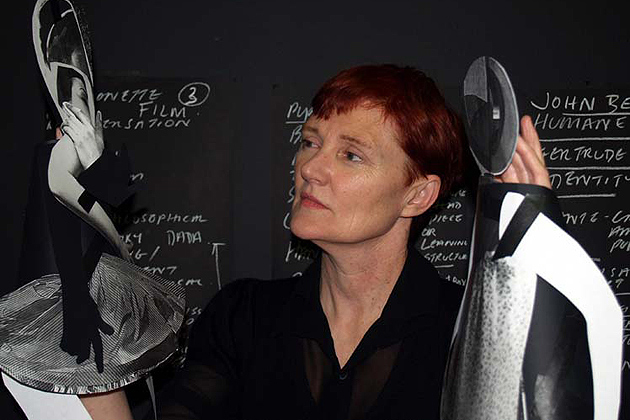
Internationally renowned artist Sally Smart is creating a new body of work as the 2012 Raymond and Beverly Sackler Artist-in-Residence at the University of Connecticut, drawing upon the specialized resources of the School of Fine Arts to explore time-based media and performance.
The new work, “The Pedagogical Puppet: Projects by Sally Smart,” will open Sept. 24 in the Contemporary Art Galleries, 830 Bolton Road, Storrs, and continue through Oct. 27. Some elements of Smart’s work will immediately be part of her upcoming shows in New York and Melbourne, and the entire exhibition will eventually travel to London and Hong Kong.

Smart, an Australian artist recognized for producing stunning, large-scale wall installations made of various media, is working with UConn faculty, students, and varied resources within the School of Fine Arts, including the world-renowned Puppet Arts Program and Ballard Institute & Museum of Puppetry Arts and the Digital Media Center.
“Over the last 20 years I’ve worked across various media from painting to more often with large scale installation work, cutting fabric materials, photography, and collage, pinning these large-scale elements that I create directly to the gallery wall,” Smart says. “But the element I haven’t had is film and animation. That is the element I wanted to engage in. I wanted to extend the medium; it was just calling out. The work was telling me it wants to move.”
When completed, “Pedagogical Puppet” will include a series of short films featuring puppets, including a marionette of Smart that will be constructed by the UConn Puppetry Program; a storyboard that traces the creation of the exhibit such as drawings, scripts for the films, and various parts of the exhibition construction; and other elements of the creative process for the exhibition. The works will be displayed across the three exhibition rooms of the Contemporary Art Galleries.
Smart says that to utilize the resources of a major research university, drawing on the expertise of faculty in other fields of art and technology to create a new work of art, is an unusual opportunity for an artist.
“This is a unique moment, where I have it all here,” she says. “The University is giving me that moment. It’s like a working laboratory.”

Barry Rosenberg, curator of the Contemporary Arts Galleries, says that having an artist of the caliber of Smart be able to use the resources of a research university is “at the heart” of the mission of a contemporary art gallery.
“We’ve done things with mathematics and environmental science and marine science,” he says of topics focused on by artists working with other UConn academic departments. “Knowing Sally and what she did, she is the perfect element to show what is possible in the School of Fine Arts.”
Rosenberg began discussions with Smart about providing the opportunity to create a new multimedia work as the Sackler Artist-in-Residence after seeing her 2011 exhibition “Flaubert’s Puppets” at the Postmaster Gallery in New York City. The exhibition featured cut-out, hybridized figures, legs, arms, and swishing skirts that came together to accentuate movement.
In the months before her arrival in Storrs, Rosenberg also invited Smart to participate in a graduate seminar on curatorial practice that he taught last year with Anne D’Alleva, professor and chair of the art and art history department.
Throughout the course, students spoke with Smart via Skype, studied her artwork, and read materials the artist recommended.

Using a grant, Rosenberg traveled to Australia to meet with Smart in her studio, where she built a scale model of the Contemporary Art Galleries as part of developing her plan for the exhibition.
“That’s when we sat down and she was very clear on what she wanted to do,” Rosenberg says.
As she met in late August with various members of the faculty at UConn, Smart says she thought of new ways to incorporate their expertise into the general direction she had developed for her work, opening up new ideas for the project.
“When you are creating new work, you don’t plan it completely,” says Smart. “I haven’t seen it before, because I haven’t seen it exist before. It’s new research. It’s within a spectrum, sure, but there is not really a roadmap where I’m going. It’s adventurous, exciting, and also it feels dangerous. And that’s good.”
Prior to the opening of “The Pedagogical Puppet,” there will be a dialogue focusing on puppetry and contemporary art with Smart; Bart Roccoberton Jr., director of the puppet arts program in the School of Fine Arts; and John Bell, director of the Ballard Institute & Museum of Puppetry Arts. The talk will be in the Art Building on Sept. 24, beginning at 4 p.m.


